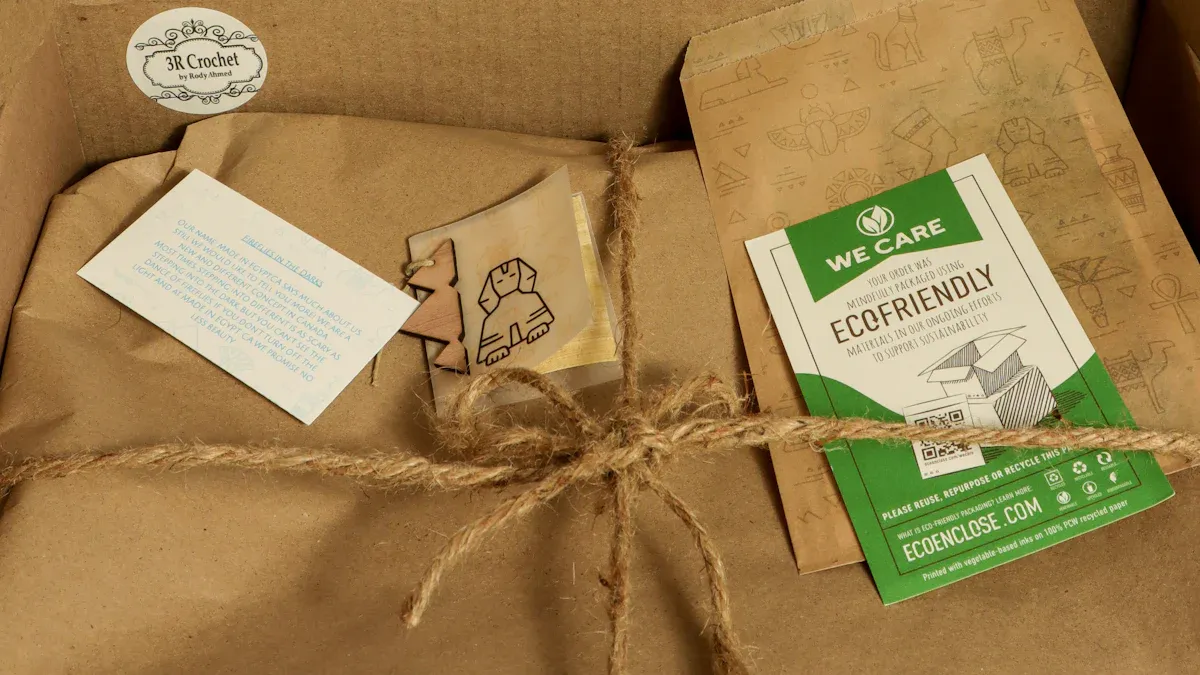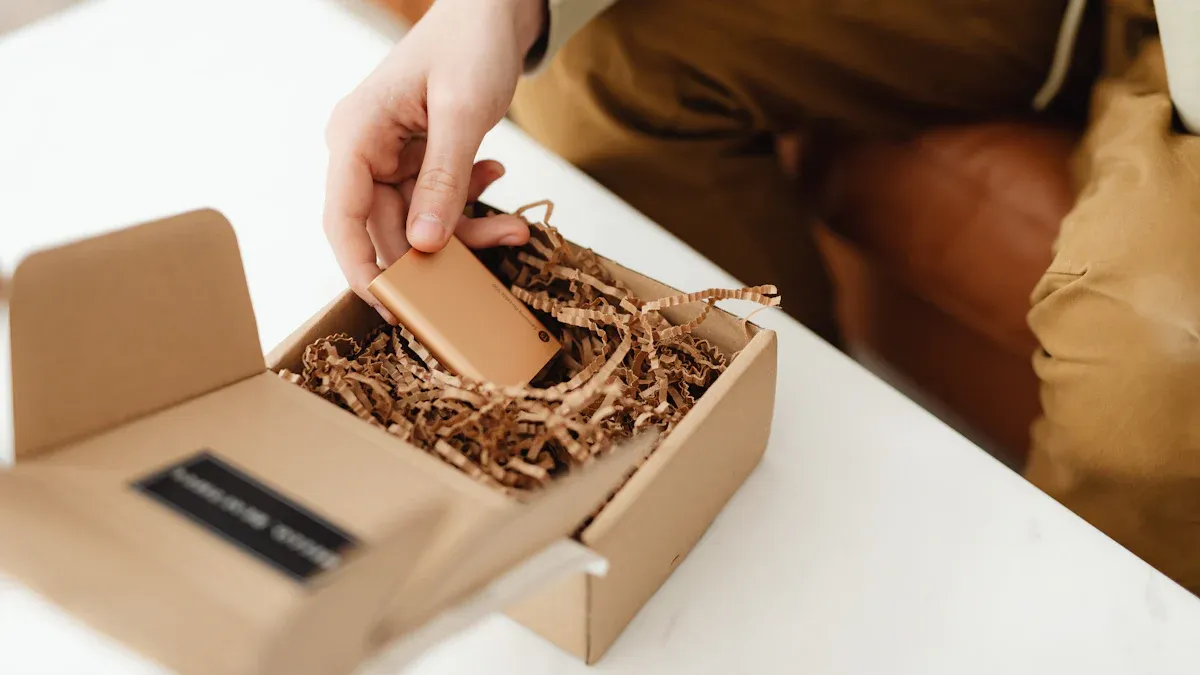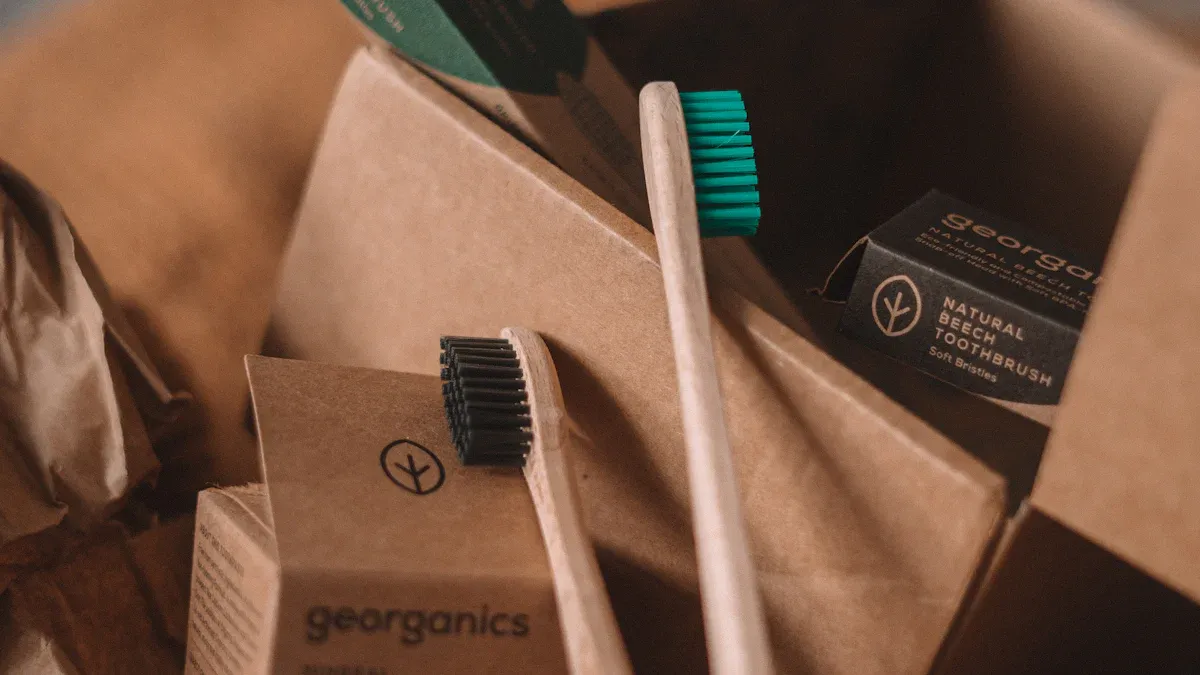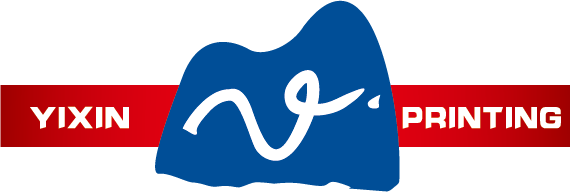
Sustainability is transforming how paper box makers operate, particularly in the realm of paper gift boxes packaging. I’ve observed a rise in eco-friendly ideas that save energy and reduce waste. For instance:
Searches for green products have surged by 71% in the past five years.
72% of consumers are now purchasing more eco-friendly items than ever before.
81% plan to increase their purchases of green products in the next five years.
Leading brands like Absolut Vodka and Mars are at the forefront of this movement. Absolut is experimenting with paper bottles to decrease pollution, while Mars is opting for paper wrappers instead of plastic. These innovations are inspiring eco-friendly designs, particularly in the area of paper gift boxes packaging, which are both practical and beneficial for the environment.
Key Takeaways
Eco-friendly methods in making paper boxes are growing fast. They use recycled materials to cut waste and save energy.
New materials like bamboo and sugarcane leftovers are now common. This shows a move to using renewable items for packaging.
Factories use energy-saving ways like renewable power and better machines.
These steps reduce pollution and make production faster.
Use of Recycled and Sustainable Materials

Recycled Paper and Cardboard
Recycled paper and cardboard are now very important in manufacturing. These materials cut down the need for new resources. They also help reduce harmful gas emissions. For example, cardboard can be recycled up to 25 times before it wears out. This makes it a smart choice for eco-friendly production. Recycling one ton of paper creates 800 kilograms of recycled fiber. This saves a lot of wood and energy.
At YiXin Printing, we follow the ideas of reducing, reusing, recycling, and redesigning. These methods lower harm to the environment while keeping our paper boxes high quality. By using recycled materials, we support a system where resources are reused. This helps the planet and meets the need for green packaging.
Alternative Fibers and Innovative Materials
Using alternative fibers is another big step in making paper boxes. Bamboo, sugarcane waste, and farm leftovers are becoming popular. These materials are renewable and better for the environment. Reports say recycled fibers will make up over 53% of the market by 2024. This shows how much people care about sustainability.
The food and drink industry is leading the way in using new materials. They hold over 43% of the market share. This is because of stricter rules on plastic and the need for eco-friendly packaging. At YiXin Printing, we are testing these materials to make strong and green paper boxes. These new ideas will change packaging, helping both the planet and businesses.
Energy-Efficient Manufacturing Processes
Renewable Energy Integration
Renewable energy is changing how paper boxes are made. Many factories now use solar, wind, and biomass energy. This helps them use less fossil fuel and cut pollution. For example, Kruger Inc. improved their Trois-Rivières plant with a steam box. This tool saves over one million cubic meters of natural gas yearly. It also lowers greenhouse gas emissions by nearly 2,000 tonnes each year. Financial help from Énergir made this upgrade possible.
These changes show renewable energy’s big impact. By using similar ideas, factories can save energy and help the planet. I think this is the future of eco-friendly manufacturing.
Energy-Saving Equipment and Technologies
Energy-saving machines make paper box production better and greener. New machines use less energy but still work well. Since 2005, the paper industry has cut greenhouse gases by over 24%. From 2000 to 2018, nitrogen oxide emissions dropped 48%, and sulfur dioxide fell 82%.
These results prove how helpful new technology is. Many factories now focus on upgrading to save energy. This helps the environment and makes work more efficient. By using these tools, the industry moves closer to a greener future.
Water Conservation and Waste Reduction
Closed-Loop Water Systems
Saving water is now very important for paper box makers. Closed-loop water systems are a great way to do this. These systems clean and reuse water during production. This means factories need less fresh water. Reusing water also lowers waste and helps the environment.
Some factories can now reuse up to 90% of their water. This saves money on buying water and treating wastewater. It’s amazing how technology is changing water use in factories. This method helps companies stay green and work efficiently.
Zero-Waste Policies and Waste Repurposing
Zero-waste rules are changing how factories deal with trash. These rules aim to keep 90% of waste out of landfills. Factories now find smart ways to turn waste into new products. For example, leftover paper can become pulp for new boxes.
These practices also help the economy. In South Carolina, recycling has created over 54,000 jobs and added $13 billion to the economy. In Minnesota, reuse programs make $4 billion in sales yearly. Recycling creates nine times more jobs than throwing trash away. Here’s a simple table:
These facts show how zero-waste ideas help both the planet and the economy. By using these methods, factories can lead the way to a greener future. 🌱
Eco-Friendly Packaging Design for Paper Gift Boxes Packaging

Lightweight and Minimalist Packaging
Lightweight and simple packaging is now very popular. Using fewer materials helps save money and reduces waste. Lighter boxes are also easier and cheaper to ship. Many companies now make thinner boxes or remove extra layers. This saves resources and attracts eco-friendly buyers.
Minimalist designs have shown great results. For example, Chihchia Chen made ceramic packaging using only paper. This cut down the need for plastic and foam. Kyeungjin Min created Korean gift boxes from recycled paper. These designs prove that small changes can help the planet.
Biodegradable and Compostable Coatings
Biodegradable coatings are a big step forward in packaging. Old coatings often had plastic, which takes years to break down. Now, companies use plant-based coatings like soy or corn starch. These break down naturally and don’t harm the environment.
This is especially useful for food packaging. Coatings protect food from moisture but can still be composted. Switching to these coatings helps companies stay green. I think more industries will follow this trend to protect the planet.
Circular Economy in Paper Box Manufacturing
Recycling and Reusability in Packaging
Recycling and reusing are key to making paper boxes greener. Many companies now focus on using old materials to cut waste. For example, sales of used cardboard boxes have grown three times recently. This shows businesses are choosing eco-friendly methods. Cardboard is biodegradable and breaks down in about a year. Its cellulose makeup makes it great for green packaging.
In 2021, the UK recycled 71% of paper and cardboard packaging. This is much higher than the 44% recycling rate for plastic. These facts show how paper materials help the environment. Recycling reduces the need for new resources and lowers pollution. I think this method helps the planet and meets the demand for eco-friendly products.
Molded Fiber Packaging Solutions
Molded fiber packaging is a smart, green option for boxes. It’s made from recycled paper pulp and can break down naturally. More people now prefer this over plastic packaging. A report said 76% of U.S. shoppers looked for green products last year. This shows how popular molded fiber is becoming.
Companies like UFP Technologies make molded fiber packaging for electronics. It protects items and cuts carbon emissions at the same time. These solutions are better for the planet and work well. I believe molded fiber will keep changing packaging for the better. It’s a step toward a cleaner future.
Paper box makers are setting examples in eco-friendly production. They recycle materials, use less energy, and save water. These changes help the environment and make better products. The rise in paper gift boxes shows how these ideas encourage other industries to go green.
FAQ
Why are paper boxes better for the environment than plastic?
Paper boxes break down quickly and can be recycled easily. They are made from renewable materials like trees or recycled paper, making them a more eco-friendly option.
How do I know if a paper box is eco-friendly?
Check for labels like FSC (Forest Stewardship Council) or ones showing recycled content. These labels mean the product follows green standards and supports good forestry practices.
Tip: Look for labels that say biodegradable or compostable to ensure it’s eco-friendly.
Can biodegradable coatings be used safely for food packaging?
Yes, they are safe and work well. Coatings made from plants like soy or corn starch keep food fresh and break down naturally without leaving harmful waste.

